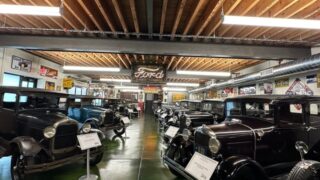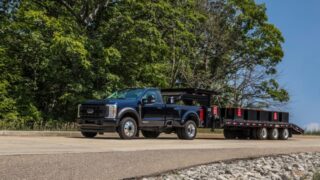|
By William Dahn
(Editor’s Note: This article details installation of a Delco 1 wire alternator in a 1966 F-100 with a 352 V8. Installation should be similar for any 1961 – 1979 F-series truck.)
MOTIVATION:
The first and for me the most obvious question I had to answer
before starting this project was "Why"? For me the answer
is simple, this project is in keeping with my philosophy of making my
driven daily truck technologically new without sacrificing practical
originality. You noticed I said practical originality, I am not a
purist and I believe this "original" business is best
applied to historical and museum quality restorations. I on the
other hand enjoy my old truck so much that I literally drive it every
day. So for me, installing a technologically advanced one wire 85
amp charging system was an easy decision.
INSTRUCTIONS:
What follows is a step by step installation process along with
parts and tool requirements. Ford used two mount locations for
alternators and generators on FE engines, one at cylinder head level,
the other about 8 inches lower. I chose to use the lower location.
Firstly the large 85 amp alternator didn’t fit in the upper
location (it is too long), and the upper location is to close to heat
generating sources (against the head and above the exhaust manifold).
The lower location is cooler. Delco alternators run a little hot
anyway so I wanted to install it where it would be as cool as
possible. Lastly, the lower location looks cleaner and provides a
less cluttered appearance. The smaller 45 amp Delco alternator will
fit easily on the upper location. The wiring connections are the
same.
IMPORTANT
NOTE: The pivoting mounting bolt for the Ford Alternator is 7/18
inches in diameter, the Delco is 1/2 inch. This necessitates
drilling out the alternator mounting bolt hole to accept the larger
7/18 inch bolt. I performed this operation by putting the
alternator in a vice and carefully running a 7/18 inch bit through
the pivot bolt hole.
PARTS:
85
Amp Delco Alternator purchased without core at Napa for $91.00
42
inch fan belt purchased at Napa for $6.95
Delco
GM alternator connector plug purchased at Napa for $6.89
Some
red 10 gauge primary wire
Some
green 18 gauge wire
GM
Battery cable with extra 10 gage wire installed
Heat
shrink
Aluminum
alternator pivot bolt spacer with a 7/16 inch hole. The original
steel spacer and some flat washers will also work
Miscellaneous
solder less electrical connectors, wire ties and flexible wire cover
Lower
mounting bracket from a 66 Galaxy with a 390
Late
sixties/early seventies F100’s with a 390 or 360 motor are also a
good source for these brackets
TOOLS;
A
small hand grinder to work on the engine block cast flashing and to
grind a little off the alternator adjusting arm for clearance at the
vibration damper.
Wire
cutter.
Wire
crimper.
3/8
drive socket set
REMOVE:
Place
a piece of cardboard between the fan and radiator to protect the
radiator from loose parts and wrenches. Pull the battery, positive
battery cable, alternator, alternator to regulator wiring harness and
the voltage regulator. Near the regulator is a connector with a 18
gage green wire with brown stripe paired with a yellow16 gage wire.
The green/brown wire will connect to the alternator and operates the
ALT light in the instrument cluster. I cut the Ford plug off and
install a Weather Pack Connector on the green/brown wire. The yellow
wire operates the horn and it is hot with the ignition on.
Loosen
and remove accessory drive belts. Remove the fan and water pump
pulley. Take off all the original alternator mount brackets and
clean the area you will be working in. Now is a good time to grind
off any cast flashing from the engine block near the timing chain
cover and on the corner of the block below the exhaust manifold.
Doing this will provide a little extra movement of the alternator
when you install the belt and it makes things neater. Run a tap in
threaded holes and use a little air or WD 40 to clean any debris out
of these holes.
MECHANICAL
INSTALL:
The
mounting bracket, alternator, pivot bolt, spacer and the adjusting
arm. The adjusting arm may require some grinding to provide
clearance between it and the vibration damper. Use a bolt with
metric thread to fasten the adjusting arm to the alternator and just
for good measure put a nut on the end where it threads through the
alternator. Trial fit everything, tighten the mounting bolts finger
tight until you are sure everything fits nicely without binding. The
alternator drive belt must ride straight over the alternator pulley,
the water pump pulley and the vibration damper pulley. Use wire ties
and a flexible wire cover for the wires and harness you built.
WIRING
DIAGRAM:
Install
a red 10 gauge wire with a crimp on ring connector from the battery
post terminal on the alternator to the positive post on the battery.
I used a new red GM Positive battery cable with an extra attached 10
gage wire. A 10 gage wire from the battery post terminal on the
alternator to the positive battery cable side of the starter relay
will also work. It’s just that the GM battery cable has this extra
wire and makes for a neater installation. I shortened the GM battery
cable and soldered on a new end connector. Get a metric nut to attach
the ring connector to the battery post on the alternator. I think
next time I’ll just run a 10 gage wire from the alternator battery
post over to the starter relay.
The
Delco GM alternator connector is keyed to fit and will only plug into
the alternator one way (the right way). It has two 18 gage leads, a
white one (blue on the wiring diagram),
with solder less crimp connector installed and a red lead about three
inches long with a ring connector. The red wire with ring connector
connects to the battery post on the alternator, (same post as the 10
gage wire running to the positive battery post). The other wire
(mine is white), connects to the ALT light. From the white lead on
the alternator plug in connector, run a 18 gage wire under the
battery box, up and across the radiator core support and crimp
connect it to the 18 gage green with brown stripe alternator charging
lamp indicator wire from the bulkhead connector. This circuit
operates the alternator charging lamp indicator. The alternator will
work fine with out the charging lamp connected. I prefer to connect
this circuit and use an ALT light. The green wire with brown stripe
is paired with an 18 gage yellow wire that connects to the horn
relay. The yellow wire on the alternator diagram is not used in this
application.
TEST:
Turn on the key, the ALT light should come on. Start the
engine, the ALT light goes out. Measure alternator voltage output,
across the battery posts. The reading should be 13.5 to 14.5 volts
with the engine running at idle. The same reading should be 12
volts with the engine off. when the engine starts.
ACKNOWLEDGEMENTS:
Trail
Rider, for advice and the wiring schematic.
Sparky,
for lots of really good electrical information.
Use
a keyed plug in connector for terminal one and two.

Yellow
lead is not used.
Red
lead (BATT) connects to the positive battery post.
Blue
connects to the ALT light (green with brown stripe) on 66 F100s.
|





